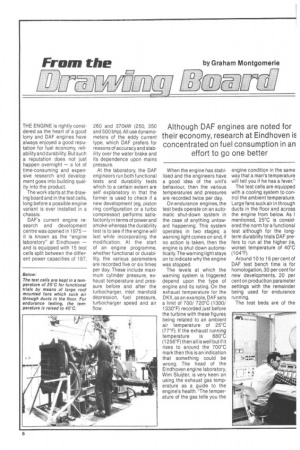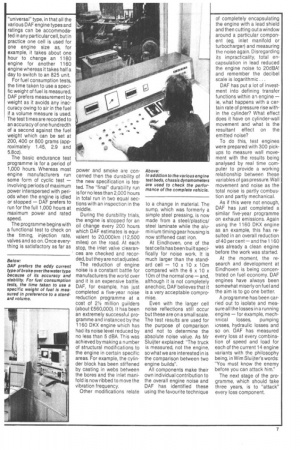From the
Page 34

Page 35

If you've noticed an error in this article please click here to report it so we can fix it.
mr
by Graham Montgomerie
Although DAF engines are noted for their economy, research at Eindhoven iF. concentrated on fuel consumption in an effort to go one better
THE ENGINE is rightly considered as the heart of a good lorry and DAF engines have always enjoyed a good reputation for fuel economy, reliabilityand durability. But such a reputation does not just happen overnight — a lot of time-consuming and expensive research and development goes into building quality into the product.
The work starts at the drawing board and in the test cells, long before a possible engine variant is ever installed in a chassis.
DAF's current engine research and development centre was opened in 1975 — it is known as the "engine laboratory" at Eindhoven — and is equipped with 15 test cells split between the different power capacities of 187, 260 and 370kW (250, 350 and 500 bhp). All use dynamometers of the eddy current type, which DAF prefers for reasons of accuracy and stability over the water brake and its dependence upon mains pressure.
At the laboratory, the DAF engineers run both functional tests and durability tests which to a certain extent are self explanatory in that the former is used to check if a new development (eg, piston ring configuration or a turbo compressor) performs satisfactorily in terms of power and smoke whereas the durability test is to see if the engine will last while incorporating the modification. At the start of an engine programme, whether functional or durability, the various parameters are recorded five or six times per day. These include maximum cylinder pressure, exhaust temperature and pressure before and after the turbocharger, inlet manifold depression, fuel pressure, turbocharger speed and air flow. When the engine has stabilised and the engineers have a good idea of the unit's behaviour, then the various temperatures and pressures are recorded twice per day.
On endurance engines, the test beds operate on an automatic shut-down system in the case of anything untoward happening. This system operates in two stages; a warning light comes on and, if no action is taken, then the engine is shut down automatically. The warning light stays on to indicate why the engine was stopped.
The levels at which the warning system is triggered depend upon the type of engine and its rating. On the exhaust temperature for the DKX, as an example, DAF sets a limit of 700/ 720°C (1300/ 1330°F) recorded just before the turbine with these figures being related to an ambient air temperature of 25°C (77°F). If the exhaust running temperature is 680°C (1256°F)then all is well but if it rises to around the 700°C mark then this is an indication that something could be wrong. The head of the Eindhoven engine laboratory, Wim Sluijter, is very keen on using the exhaust gas temperature as a guide to the engine's health. "The temperature of the gas tells you the engine condition in the same way that a man's temperature will tell you if he has a fever."
The test cells are equipped with a cooling system to control the ambient temperature. Large fans suck air in through ducts in the floor and across the engine from below. As I mentioned, 25°C is considered the norm for a functional test although for the longterm durability trials DAF prefers to run at the higher (ie, worse) temperature of 40°C (104°F).
Around 10 to 15 per cent of DAF test bench time is for homologation, 30 per cent for new developments, 20 per cent on production parameter settings with the remainder being used for endurance running.
The test beds are of the "universal" type, in that all the various DAF engine types and ratings can be accommodated in any particularcell, but in practice one cell is used for one engine size as, for example, it takes about one hour to change an 1160 engine for another 1160 engine whereas it takes half a day to switch to an 825 unit.
For fuel consumption tests, the time taken to use a specific weight of fuel is measured. DAF prefers measurement by weight as it avoids any inaccuracy owing to air in the fuel if a volume measure is used. The test ti mes are recorded to an accuracy of one hundredth of a second against the fuel weight which can be set at 200, 400 or 800 grams (approximately 1.45, 2.9 and 5.8 oz).
The basic endurance test programme is for a period of 1,000 hours. Whereas most engine manufacturers run some form of cyclic test — involving periods of maximum power interspersed with periods when the engine is idled or stopped — DAF prefers to run for the full 1,000 hours at maximum power and rated speed.
The programme begins with a functional test to check on the timing, injection rate, valves and so on. Once everything is satisfactory as far as power and smoke are concerned then the durability of the new specification is tested. The "final" durability run is for no less than 2,000 hours in total run in two equal sections with an inspection in the middle.
During the durability trials, the engine is stopped for an oil change every 200 hours which DAF estimates is equivalent to 20,000km (12,500 miles) on the road. At each stop, the inlet valve clearances are checked and recorded, but they are not adjusted.
The reduction of engine noise is a constant battle for manufacturers the world over and it is an expensive battle. DAF, for example, has just completed a five-year noise reduction programme at a cost of 21/2 million guilders (about £560,000). It has been an extremely successful programme and instanced by the 1160 DKX engine which has had its noise level reduced by no less than 5 dBA. This was achieved by making a number of structural modifications to the engine in certain specific areas. For example, the cylinder block has been stiffened by casting in webs between the bores and the inlet manifold is now ribbed to move the vibration frequency.
Other modifications relate to a change in material. The sump, which was formerly a simple steel pressing, is now made from a steel/plastics/ steel laminate while the aluminium timing gear housing is now stiffened cast iron.
At Eindhoven, one of the test cells has been built specifically for noise work. It is much larger than the standard cell — 10 x 10 x 10m compared with the 6 x 10 x 10m of the normal one — and, although it is not completely anechoic, DAF believes that it is a very acceptable compromise.
Even with the larger cell noise reflections still occur but these are on a small scale. The test results are used for the purpose of comparison and not to determine the absolute noise value. As Mr Sluijter explained: The truck is measured, not the engine, so what we are interested in is the comparison between two engine builds'.
All components make their own individual contribution to the overall engine noise and DAF has identified these using the favourite technique of completely encapsulating the engine with a lead shield and then cutting out a window around a particular compon ent (eg, inlet manifold or turbocharger) and measuring the noise again. Disregarding its impracticality, total encapsulation in lead reduced the engine noise to 20dBA! and remember the decibel scale is logarithmic ...
DAF has put a lot of investment into defining transfer functions within al engine — ie, what happens with a certain rate of pressure rise with in the cylinder? What effect does it have on cylinder-wall movement and what is the resultant effect on the emitted noise?
To do this, test engines were prepared with 300 pick ups to measure wall move ment with the results being analysed by real time com puter to provide a working relationship between these variables of gas pressure. Wall movement and noise as the total noise is partly combustion and partly mechanical.
As if this were not enough, DAF has just completed a similar five-year programme on exhaust emissions. Again using the 1160 DKX engine as an example, this has resulted in an overall reduction of 40 percent—and the 1160 was already a clean engine before the work was started.
At the moment, the research and development at Eindhoven is being concentrated on fuel economy. DAF engines have always been somewhat miserly on fuel and the aim is to go one better.
A programme has been carried out to isolate and mea sure all the losses in a running engine — for example, mech anical losses, pumping josses, hydraulic losses and so on. DAF has measured every loss at every combina tion of speed and load for each of the current 14 engine variants with the philosophy being, in Wim Sluijter's words: "You must know the enemy before you can attack him."
The next stage of the programme, which should take three years, is to "attack" every loss component.
































































